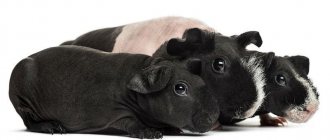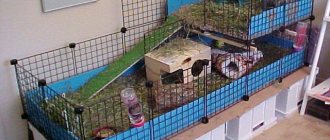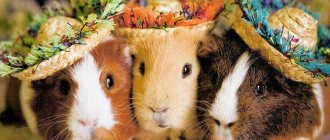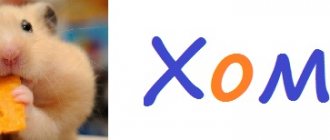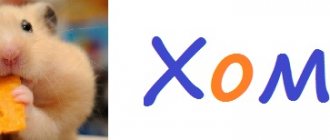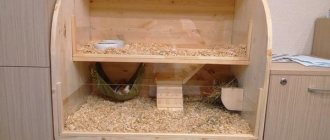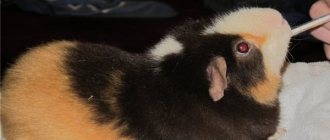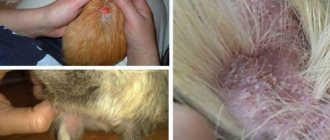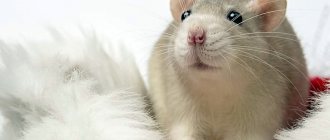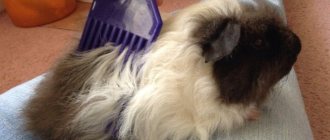!! Bedding for guinea pigs is not only a soft floor in the cage, but also a toilet and a place to play. The material used in the bedding must be soft to protect the animal’s paws from the appearance of calluses, and also have hygroscopic properties, that is, it can absorb moisture well.
It is worth remembering that a pig is a rodent that digs holes in the wild, so the litter filler should be loose. Improper selection of bedding and untimely replacement or cleaning can lead to various diseases: pododermatitis, urinary dermatitis, fungus, baldness, conjunctivitis, mechanical damage to bones, respiratory and digestive diseases, scabies, pediculosis, mites, alopecia, herpes, abscesses, cystitis, external otitis, keratitis.
Finding a material that would be universal and fit all of the above properties is almost impossible. Therefore, when creating bedding, at least two fillers are used, and sometimes even three. Fillers are arranged in layers, where the bottom layer is absorbent and the top layer is soft. The cage can also be divided into sections, which allows you to use different combinations of fillers for bedding.
Overview of different types of bedding: pine shavings
The material is well ventilated and absorbs moisture. One of the most readily available cage fillers and can be obtained from almost any carpenter. The shavings must be carefully sifted and large and sharp chips must be removed. Next, it is dried and ventilated to get rid of pine essential oils.
Pros: Low cost of the material, high hygroscopic properties, allows the pig to dig minks. Can serve as the only filler for bedding.
Cons: Risk of damage to the rodent's legs and eyes from knots. Constantly cleaning the area around the cage, as the pig will scatter shavings while playing. To avoid such a situation, plexiglass is installed in the cage.
Bed
Unlike bedding, a bed is not a mandatory attribute in a pet's cage, but a piglet will appreciate a cozy place to sleep. The bed should be spacious enough so that the animal can stretch out its legs if desired. Soft sides are also welcome; the animal can use them as a pillow.
At the pet store you can find beds of various sizes and colors. A comfortable mattress or bag can be easily made with your own hands: sewn or knitted. If the owner sewed the bed herself, taking into account all the features of the pet, then the likelihood that the animal will fall in love with the new sofa is higher.
The most popular are round-shaped beds. To sew such a basket you will need:
Product pattern
In the center there is a sleeping place, and along the edges there are sides. The length of the AB line is the length of the sleeping place, it depends on the size of the pet (it is better not to make it less than 30 cm). The height of the sides should not be too high so that the rodent can easily get into the shelter (no more than 5 cm).
Article on the topic: Leash and harness for a guinea pig, how to choose or make it yourself
Progress:
- 2 identical parts are cut from the cut.
- The parts are marked on the fabric.
- The parts are sewn together along the inner circumference, which is filled with padding polyester.
- The product is stitched according to the markings, and “pockets” are formed on the edges.
- The pockets are stuffed with padding polyester and the edges are sewn together.
- An elastic band is threaded under the transverse seam separating the pockets.
- The elastic is pulled under the basting seams over the padding polyester and tightened.
- The pockets are sewn up and the bed is ready.
Hay and straw
Hay and straw are used only in combination with other absorbent material that will absorb moisture, for example, shavings, sawdust, wood pellets. These fillers provide air access to the rodent’s belly: when the cage is poorly ventilated, the skin on the guinea pig’s belly “burns” and hair falls out due to excess moisture. Hay and straw can be bought at pet stores, but for those who want to save hay, you can make it yourself.
Hay for a pig is dried grass with stems of chamomile, dandelion, alfalfa; this composition will not only serve as bedding, but will also supplement the animal’s diet with all the necessary vitamins. It is best to make hay in the spring, when the mown grass is full of vitamins and minerals. You can dry hay on the balcony or in any other room where there is good ventilation. During drying, the hay should be turned over periodically to avoid diaper rash and damage to the material.
Pros: Hay absorbs odors perfectly, has a huge supply of vitamins and brings the pig as close as possible to the wild environment.
Cons: Hay and straw do not absorb moisture; they are used only in conjunction with absorbent filler. Straw does not absorb odors well and can injure the pig due to the sharp stems.
Items for entertainment
The guinea pig's body needs to move. The animal quickly develops the territory of the home, and its interest fades over time. In order to motivate your pet to move, it is necessary to equip the house with various toys and replace them regularly.
The comfort zone of an animal of this species is a room, which is similar to a hole. Consequently, tube-shaped objects are popular among rodents. The labyrinth can arouse interest for a long period of time. A high level of activity has a positive effect on the physiological health of gilts and helps prevent obesity.
Sawdust
This filler has good absorbent characteristics. Designed for use as the bottom layer of bedding. Sawdust can be of different fractions. Small sawdust can cause problems in the respiratory system of a rodent, so you should buy a large fraction. It is quite easy to purchase sawdust - at any pet store or furniture shop. As in the case of shavings, sawdust also needs to be dried before use and sorted out, removing all sharp chips.
Pros: Low cost of material, absorbs moisture and odors well.
Cons: The fine fraction can cause respiratory tract disease and conjunctivitis. Poor absorption of odors. Long-haired pigs will need to periodically clean their fur to remove sawdust. Constant cleaning of the area around the cage.
Special toilet fillers
Not all types of special litter for toilets are suitable for a guinea pig cage. Only cellulose or wood based bedding can be used. Your pet may try to eat the litter, so clumping formulations are not suitable. It is acceptable to use silica gel litter if the pig is not interested in it as a dental trainer or treat. It is recommended to cover such a filler with a PVC mat or other bedding.
- absorbs moisture well;
- eliminates unpleasant odors;
- easy to clean.
- high cost;
- dangerous if your pet eats it.
Wood granules, pellets
Wood pellets or pellets are sawdust pressed under high temperatures. Well suited not only as litter for kittens and rabbits, but also for guinea pigs. In bedding, pellets can be used as the only filler, in combination with other fillers - sawdust occupies the bottom layer, which should absorb all the moisture. Pellets are sold in almost every construction or gardening store. But if you want to be sure of the quality of the material, then it is better to purchase pellets in pet stores, where they are packaged into fractions. You should also pay attention to what the granules are made of; it should be cellulose or wood. Otherwise, low-quality pellets can cause problems in the pig’s digestive tract, because she will chew them.
Pros: Easy to use, absorbs moisture and odor, can be used as the only bedding filler.
Cons: Constant cleaning around the cage, cost of material.
Instructions for making a fabric house
A fabric tent must have a metal frame base. The metal mesh is bent and covered with a fabric cover. It is recommended to use nylon or fleece. Nylon is easy to clean. Your pet will love fleece for its softness and warmth. Cardboard is sometimes attached to the mesh. These are the future roof and side walls of the house. You can use another piece of fabric as the back wall. Fleece or other bedding is placed at the base of the fabric tent. The fabric tent has many color options, is lightweight and easy to clean. But this option is short-lived, since the animal can chew it off. And then you will have to re-cover the structure with fabric.
Napkins, paper towels
Napkins and paper towels can be used as a temporary moisture-absorbing filler for bedding, which is used only in combination with other material: shavings, hay, fleece and PVC mats. As for newspapers, their use is strictly prohibited, because printing ink is toxic to pigs due to its lead content.
Pros: Low price, hypoallergenic, accessible.
Cons: Gets wet quickly. Can only be used mixed with other fillers
Guinea pig litter)
11 messages
The filler layer should be approximately 3-5 cm across the entire cage tray, change as it gets dirty.
Wood granular filler (pellets)
pellets During production, raw materials (sawdust, bark, etc.) enter a crusher, where they are crushed to flour. The resulting mass enters the dryer, from which it goes into a granulator press, where wood flour is compressed into granules. A natural component of wood, lignin, is used as a gluing component, which glues the particles together when a certain temperature is reached. The finished pellets are cooled and packaged in plastic bags. The granules excellently retain odor and moisture and are economical. Cons: dusty, noisy, can lead to dermatitis due to hardness.
On top of the granules, you must definitely pour a thick layer of sawdust, paper or cotton filler, put fleece or lay a PVC mat.
Sold in household stores, hypermarkets, and “Everything for the Bathroom” departments. Under it, a layer of any filler (from those listed in the article) is required. It is better to use granules under the rug, because this type of filler retains odor better than all others, and the same sawdust begins to smell very quickly, and so does the rug. In addition, sawdust does not absorb anything. Granules lock in odor and absorb moisture. The rug is shaken out of feces every day. Washable 1-2 times a week in a machine (15 minutes) at 30 degrees without spinning, or by hand. Therefore, you need to have two per shift. Before washing, rinse with water. The purpose of the mat is not to absorb urine. On the contrary, it should allow urine to pass through the holes onto the filler + its direct purpose is to protect the paws from hard granules, food from sawdust (so that nothing sticks to the bud), so that sawdust dust and the sawdust themselves do not get tangled in the fur, as well as protecting the pig’s lungs and owners from wood dust. Pros: no debris flying out of the cage, gentle on the paws, food does not get dirty in the litter. Cons: the rug can be chewed, then you should turn it over to the other side or remove it completely.
Article on the topic: How to train a guinea pig to the toilet (tray) in one place
One of the most common filler options.
The disadvantages are that they absorb odors much worse, get wet quickly, and can cause an allergic reaction (the most common symptoms are sneezing and itching) to the smallest, dust-like particles present in any sawdust package. Therefore, a medium or large fraction containing less dust is usually used as a filler. When using sawdust, ensure that all sharp splinters are removed
Cat litter
For keeping pigs, it is necessary to use litter made exclusively from cellulose or wood. Therefore, when purchasing, carefully read the composition of the granules. You cannot use clumping fillers, because... Pigs love to taste everything. And eating such a filler can be fatal, causing intestinal obstruction, gastrointestinal stasis, injuries to the esophagus and stomach.
It consists of crushed corn cobs and comes in three types - fine fraction, coarse fraction and granules. Cons: high price, can become moldy from moisture, insects and larvae can grow in it. Some owners note poor absorption and does not absorb odors well enough. Pros: hypoallergenic.
Paper towels / Napkins / Toilet paper
Pros: does not rattle, does not generate dust, low price, availability, hypoallergenic. Cons: impractical. The paper will be instantly wet. Mixed use along with other filler is possible.
Under no circumstances should it be used as newspaper filler. Printing ink is very toxic.
3df7e8d32e1179cb915ff595174ec162In the West it is widely used as bedding filler. The only fleece that is suitable is one that is 100% polyester and is slightly different on both sides. Should not form pellets on the surface after washing. You need to have 2-4 sets in stock, which will change throughout the month. Pros. Can be used repeatedly and repeatedly. Animals like this kind of bedding. It is pleasant to the touch, warm, despite this the pig will not overheat, it is dry, and allows it to burrow into layers of fabric (imitation of burrows). It looks aesthetically pleasing and neat. The likelihood of chewing fleece is the same as eating sawdust, pellets, etc.
Article on the topic: Names for guinea pigs for boys and girls, how to choose the right nickname
After purchasing, a piece of fleece must first be washed 2-4 times (without rinse aid, it impairs the moisture permeability of the fabric!) and dried. Washing is necessary to make the fabric more moisture permeable; After the first wash, the fleece will “shrink” and take on its final size. Only then can it be cut and used directly for its intended purpose. Fleece does not absorb urine, but passes it through. Therefore, there should be an additional layer under the fleece. The surface of the fleece remains dry. If fleece still does not allow liquid to pass through, but retains it, this can be explained by the following errors: too many layers of fleece; the filler under the fleece does not retain moisture; the fabric was washed with fabric softener; The fleece was not washed several times before use.
Fleece is placed in 1-2 layers and 1-2 layers of towels or paper, or disposable diapers. The simplest and cheapest thing is paper, but it gets wet quickly and does not retain odors. The most convenient are disposable diapers, but they are also the most expensive option. The most practical thing is towels, but they need to be washed much more often than the fleece set itself. For the best effect, it is recommended to combine all this in the following sequence: fleece on top, then towel, paper, disposable diaper.
PVC and fleece rugs
Rugs made of PVC and fleece are popular materials for bedding; they are used only in combination with other fillers that will absorb moisture: sawdust, shavings, pellets. These rugs have a colorful design, in the form of pictures on different topics. When choosing such a rug, you should pay attention to the fact that it must consist of 100% polyester. The surface of the mat should not contain long threads in which the pig could become entangled. You need to wash the rug without fabric softener, because it significantly impairs the water permeability of the material.
Pros: These rugs are warm, soft and aesthetically pleasing; they can be reused many times.
Cons: Small debris sticks to the material and is very difficult to clean off; washing is required.
There are many materials for filling bedding; every guinea pig owner will be able to choose a filler for the cage according to their wallet. But all types of bedding must be promptly replaced and the cage cleaned.
Why do pets need bedding?
The filler, produced from various components, is used as a sorbent, that is, it is intended to absorb liquids and retain odors. The specific method of use is determined by what species the pet belongs to:
Cats and small dogs are usually trained to relieve themselves in a litter tray installed in the far corner of the apartment. There they can do the job and bury the excrement, hiding the smell, as their ancient instinct requires of them. The choice of type and manufacturer of bedding will be greatly influenced by the preferences of a particular animal; the more comfortable it is, the less trouble the owner will have.
Small animals, such as hamsters, rats and other rodents, spend more time rummaging through the litter and find many more uses for it. Firstly, the material still acts as a sorbent and is used as a toilet. Secondly, rodents love to chew something from the litter, especially when it comes to sawdust or corn. Thirdly, part of the filler will inevitably be spent on arranging the hamster’s personal shelter.
To create comfort, bedding is also placed at the bottom of bird cages. Birds like to take straws and pellets into their beaks, rummage through the litter and throw them around
However, most of the time they sit on perches, which means that what lies below is less important for them than for hamsters or guinea pigs
Large animals like horses spend most of their lives in a stall. Consequently, their health, appearance, and mood directly depend on the bedding in the stable. Therefore, increased requirements for hypoallergenicity, antiseptic properties, and ease of cleaning are applied to the material. A significant criterion is the price of the bedding used due to the rapid consumption of raw materials.
Cleaning the cage
You need to clean your guinea pig's cage daily, following this procedure:
- The first step is to remove any remaining food and waste.
- Next, wipe the contaminated areas with wet paper towels.
- Change water and food. In this case, the bowls must be washed each time in hot, soapy water.
At least once a week, the cage should be thoroughly cleaned. During such cleaning, all bedding is removed from the cage, everything is washed in hot water. The cage is washed with mild detergents, wiped down and filled with bedding. The amount of litter directly depends on the size of the cage. As a rule, the bottom of the cage is filled several centimeters so that the pig can move around without hindrance.
ARTICLE 2: Himalayan guinea pig - Description and photo
Home improvement
In pet stores, each owner has the opportunity to purchase a complete cage, as well as furnish a home for their beloved pet with all the important objects themselves. Every item used by the pig must be firmly secured to the walls and placed stably in the cage.
The pet owner will need to purchase the following pet supplies:
- Drinking bowl.
- Feeder.
- Tray for filler.
- Game items.
- Collect into several tree branches.
Using a drinking bowl allows the animal to avoid splashing liquid and getting wet. It is necessary to replenish the water every day. The amount of liquid depends on the number of pets in the home. For a group of animals, use several smaller drinking bowls.
Next to the drinking bowl is a food consumption area. You need to buy a separate feeder if you use different types of feed. Green, juicy, rough food should be placed separately from each other. It is worth creating conditions in your pet’s home that will be close to the natural environment.
The animal needs rough objects to grind its teeth. Place any tree branches, except coniferous ones, as well as small mineral stones. Correctly determined height of hanging accessories will not be a harbinger of injury, but will improve the mood of your favorite animal.
Bedding for guinea pigs: recommendations for choosing
!! Bedding for guinea pigs is not only a soft floor in the cage, but also a toilet and a place to play. The material used in the bedding must be soft to protect the animal’s paws from the appearance of calluses, and also have hygroscopic properties, that is, it can absorb moisture well.
It is worth remembering that a pig is a rodent that digs holes in the wild, so the litter filler should be loose. Improper selection of bedding and untimely replacement or cleaning can lead to various diseases: pododermatitis, urinary dermatitis, fungus, baldness, conjunctivitis, mechanical damage to bones, respiratory and digestive diseases, scabies, pediculosis, mites, alopecia, herpes, abscesses, cystitis, external otitis, keratitis.
Article on the topic: What to feed a Djungarian hamster at home, what Djungarian hamsters eat, nutrition table (list: do’s and don’ts)
Finding a material that would be universal and fit all of the above properties is almost impossible. Therefore, when creating bedding, at least two fillers are used, and sometimes even three. Fillers are arranged in layers, where the bottom layer is absorbent and the top layer is soft. The cage can also be divided into sections, which allows you to use different combinations of fillers for bedding.
